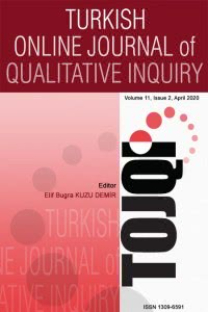What Makes a Good Research Paper? Examining Differences and Similarities in Turkish and American Expectations
İyi Bir Araştırma Makalesi Nasıl Olur? Türk ve Amerikan Beklenti Arasındaki Benzerlikler ve Farklar
___
Bell, J. (1993). Doing your research project. Buckingham: Open University Press.Bruffee, K. (1986). Social Construction, language, and the authority of knowledge: A Bibliographical essay. College English, 48(8), 773-789.
Byram, M., Gribkova, B., & Starkey, H. (2002). Developing the intercultural dimension inlanguage teaching: A practical introduction for teachers. The Council of Europe. Retrieved April 29, 2009 from http://lrc.cornell.edu/director/intercultural.pdf
Collier, P., & Weininger, D. (2008) “Is that paper really due today?”: Differences in first-generation and traditional college students’ understandings of faculty expectations. Retrieved April 29, 2009 from http://link.springer.com/article/10.1007%2Fs10734-007-9065-5
Crozet , C., Liddicoat , A.J., & Lo Bianco, J. (1999). Intercultural competence: From language policy to language education. In J. Lo Bianco, A. Liddicoat & C. Crozet (Eds), Striving for the third place: Intercultural competence through language education. Melbourne: Language Australia.
Dörnyei, Z. (2007). Research methods in applied linguistics: Quantitative, qualitative and mixed methodologies. Oxford: Oxford University Press.
Fontana, A., & Frey, J. H. (2000). The interview: From structured questions to negotiated text. In N. K. Denzin & Y. S. Lincoln (Eds.), Handbook of qualitative research (2nd ed., pp. 645–672). Thousand Oaks, CA: SAGE Publications.
Lui, S. (2010). Teaching English in China: Conflicts and expectations. The International Journal - Language Society and Culture, 31, 90-97.
Glaser, B., & Strauss, A. (1967). The discovery of grounded theory: Strategies for qualitative research. New York: Aldine De Gruyter.
Mills, J., Bonner, A., & Francis, K. (2006). The development of constructivist grounded theory. International Journal of Qualitative Methods, 5(1), 1-10.
Parrish, P., & Linder-VanBerschot , J.A. (2010). Cultural Dimensions of Learning: Addressing the Challenges of Multicultural Instruction. International Review of Research in Open and Distance Learning,11(2): 1-19.
QS World University Rankings (2012). Increase in Number of International Students. Retrieved 12 September, 2012 from http://www.topuniversities.com/university-rankings-articles/worlduniversity- rankings/increase-number-international-students.
Schmitt, D. (2012, November 13). UK universities failing to bridge culture gap for foreign students. The Guardian. Retrieved from http://www.theguardian.com/education/2012/nov/13/international-student-testing-culturegap
Strauss, A. L. (1987). Qualitative Analysis for Social Scientists. Cambridge: Cambridge University.
Taylor, George R. (2000). Integrating quantitative and qualitative methods in research. Lanham, MD: University Press of America.
Wang, J., Lin, E., Spalding, E., Odell, S.J., & Klecka, C.L. (2011). Understanding teacher education in an era of globalization. Journal of Teacher Education, 62(2), 115–120.
- ISSN: 1309-6591
- Yayın Aralığı: 4
- Başlangıç: 2010
- Yayıncı: Prof.Dr. Abdullah Kuzu
YASEMİN KARAL, HASAN KARAL, A. Mevhibe COŞAR, TANER ALTUN, Lokman ŞİBIR, EKREM BAHÇEKAPILI, MURAT ATASOY, Ahmet PALANCI
Bir Öğretmenin Teknoloji Entegrasyonu Yolculuğu
Betül ULUYSAL, Sadife DEMİREL, ADİLE AŞKIM KURT, YUSUF LEVENT ŞAHİN
Şakire ERBAY, Elif ERDEM, Hasan SAĞLAMEL
Kitlesel Açık Çevrimiçi Derslerin Kullanımına İlişkin Uzaktan Eğitim Uzmanlarının Görüşleri
